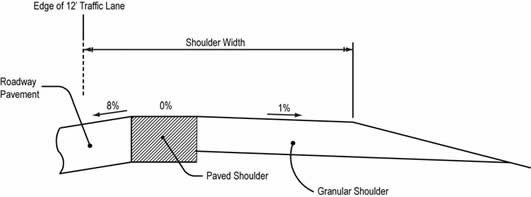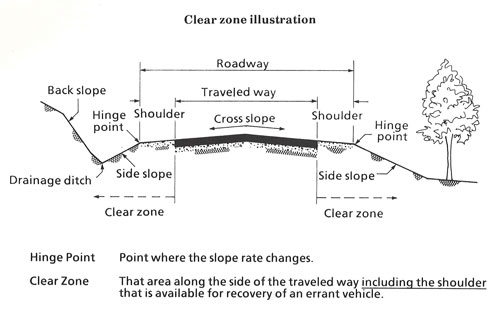Cross slope
As a cross- slope ( in Switzerland also cross slope ) the slope of the road surface (or of the underlying layers ) is called a right angle to the road axis in road maintenance and construction. As a name, the letter "q " is used, the specification is always a percentage. Thus, for example, 1 % cross slope corresponds to a height difference of 1 cm to 1 m.
The central task of the bank is to as quickly as possible and harmless remove surface water from the road surface to protect the road body against moisture and water retention or their consequences ( hydroplaning Sprühfahnen or black ice ) to prevent the surface. Already in ancient times used the Roman builders the bank for the construction of Roman roads, so that they could be used safely and permanently. In addition to dewatering, the bank also meets dynamic driving purposes, such as the inclusion or reduction of the centrifugal force in a rapidly traversed curve. Comparable to the bank in road construction is the superelevation of rails in the field of railway construction, but playing drainage technical reasons in this case does not matter.
Tasks
Primarily the transverse inclination is used for draining of road surfaces. Due to the inclination of road surfaces, the surface water is passed on as a short and rapid means to the edge of the road, there to seep either or using a dewatering device to be derived (eg road gully ). Located under the road surface layers, such as the subgrade layer are also formed by lateral inclination.
Further, the bank serves to receive the centrifugal forces occurring during cornering in part. In this way, the curve can be safely drive at a higher speed. The bank continues to serve for visual guidance of the driver, as the performance of the curve is improved.
Bank forms
Over time, various bank forms have evolved in the Road-building:
- Panel profile - the slope of the road is one-way
- Roof profile - the slope of the road falls from the center roof shape on both sides from ( and vice versa as a negative Roof possible)
- Graderprofil - similar to the roof profile, but steadily increasing cross slope on both sides ( hourglass )
- Zero crossing - horizontal position of the road in the area of Querneigungsverwindung
- Sawtooth - double and parallel Einseitneigung in roads with two separate carriageways
Limit and guideline values
In the road rules limit and guideline values for the cross slope are given in order to ensure a high degree of functionality and traffic safety. The standard cross slope of roadways is generally q = 2.5%. With increase of the speed and as a function of radius of curvature of road, and this value can be up to q = 8% increased. Deviations above and below are possible, but must be assessed in each individual case.
The cross slope on sidewalks should not exceed what is necessary for the drainage level of 2.5 % in order to prevent a necessary countermeasures for wheelchair users. In the area of property driveways or on-board reductions of up to 6 % are allowed.
Bank tape
The transverse slope strip ( also called ramp Band) is the left (solid line ) and the right edge of the roadway (dashed line ) with respect to the bridge axis (dash-dotted line) dar. Furthermore, the bank, the width of the road and, where appropriate superelevation rollover? S are written. A horizontal illustrated kerbside describes a constant course the bank, a tilted -drawn kerbside indicates a cross slope change. If there is an intersection between the road edges and the axis (for example, a distortion ) of the bank at this point is zero.
The presentation of the bank strip is carried along with the band curvature below the level plan. In this way, the construction route can be understood as a spatial structure and it can be judged simply whether all the required parameters and limits of the track alignment are met.
Norms and Standards
- Guidelines for the construction of roads - part: lines
- 3:03:23 lines
- SN 640 120 lines; Cross slope in straight lines and curves, Quergefällsänderung










